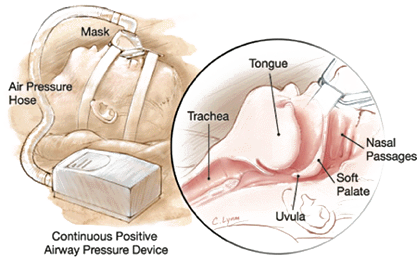Is sleep apnea common among NFL players?
Studies have indicated one-third of NFL players have Obstructive Sleep Apnea (OSA), a disorder that creates serious health risks and increases the chance that players will be sleep deprived before they hit the ground running. New research suggests that the condition could slow a player’s reaction time by 11%. One of the primary symptoms of sleep apnea is loud and frequent snoring, a common warning sign for sleep apnea. The snoring is often mixed with silent breathing pauses followed by choking or gasping sounds.
It is estimated that 22 million Americans suffer from OSA, and 80% of the cases moderate to severe will go undiagnosed. OSA is associated with daytime sleepiness, cognitive impairment, hypertension, cardiovascular disease, pulmonary hypertension, and arrhythmias as well as increased risk of motor vehicle accidents.
OSA is characterized by brief periods of interrupted breathing during sleep. Typically episodes last 10 to 30 seconds and can recur at a rate of 400 times a night.
Sleep apnea is a potentially serious type of sleep disorder in which sufferers stop breathing involuntarily as many as 20 to 30 times per hour during sleep.
OSA occurs when the trachea is obstructed, so that a person is unable to draw sufficient air into the lungs. The blockage may be caused by the person’s tongue, tonsils or uvula or by fatty tissue in the throat. Because sleep is constantly interrupted, those with sleep apnea do not get a full night of deep, restful sleep.
Fifty-two professional football players from eight randomly selected NFL teams were tested for the obstructive sleep apnea study, cited in a recent issue of The New England Journal of Medicine. The presence of sleep apnea among the pro football group was 14% overall, nearly five times higher than noted in previous studies of similarly aged adults. It was even more common for higher risk players — 34% of linebackers, defensive players responsible for stopping rushers and pass receivers, suffered from it.
High Body Mass Index or Thick-Necked Snorers at Risk for Sleep Apnea
Males, who are heavy, have thick necks and a history of snoring are at increased risk for sleep apnea, and it’s not only football players. Studies show men of similar size and age, whose physical health may not be as good as the athletes tested, may also have sleep apnea and go undiagnosed for many years. It affects members of both sexes, but is more common among men, and people with large body mass and a snoring problem.
Some may recall the sudden death in of Reggie White who played professional football for both the Philadelphia Eagles and the Green Bay Packers. White died in 2004 at the tender age of 43. It was reported that sleep apnea contributed to the heart condition that took his life. News reports about the unexpected death of Reggie White highlighted the potential danger of obstructive sleep apnea and related breathing disorders.
Other NFL players have come forth to increase awareness of OSA and the health risks associated with the all to common sleep disorder. Nate Hobgood-Chittick, for example who plays for the Kansas City Chiefs, wasn’t part of the study, but he discovered he had sleep apnea back in 1998 as a rookie with the New York Giants.
He complained of always being tired in the morning and throughout the day, but mostly in the mornings. Then, Hobgood-Chittick began to gain weight for football purposes, and his snoring increased. Typically the bed partner will witness the snoring (his wife in this case) and apneas (pauses in breathing) during sleep and they will move to another room and sleep somewhere else, which can contribute to relationship problems. Hobgood-Chittick was eventually evaluated by doctors and diagnosed with OSA.
Researchers are planning further tests to see if treating the sleep 
CPAP therapy is the treatment that Hobgood-Chittick was prescribed and uses, although he did so reluctantly. At first he said that he threw the machine across the room because he didn’t want to wear it and could not tolerate it. “It’s not exactly sexy to wear to bed. The machine is about the size of a football. There’s a tube that is attached, and a mask.” Unfortunately if players choose not to wear it, they will be tired the next morning and their performance will be compromised, as a highly paid NFL professional, staying CPAP compliant a strong motivator.
A recent online article further discussed the topic, with regard to CBS sports college football analyst Aaron Taylor who also understands the urgent need to detect and treat obstructive sleep apnea.
“Even at a young age, ignoring the symptoms of sleep apnea leads to dangerous consequences – as I’ve seen firsthand for fellow players and friends who have struggled with this condition,” said Taylor.
As elite lineman, both White and Taylor had the size and strength to excel on the football field. But their size also put them at risk for sleep apnea. Excess body weight is the major risk factor for OSA.
A sleep study eventually confirmed that Taylor has sleep apnea. Today he is successfully treating sleep apnea, using CPAP therapy at home and an oral appliance on the road. The effect on his quality of life has been remarkable. He has more energy and less daytime fatigue.
Taylor is partnering with the American Academy of Sleep Medicine (AASM) to raise awareness of sleep apnea. His passion is for young football players to understand their risk and seek medical help for suspected OSA.
“I want current and future athletes to understand the serious risks of this disease and know this isn’t something you have to live with,” he said.
Here is further clinical information on OSA:
Diagnosis:
The cardinal manifestations of the obstructive sleep apnea syndrome are snoring and severe sleepiness. However, both snoring and sleepiness may be denied or minimized by the patient. Frequently the first clue about OSA comes from a sleeping partner who complains about snoring or long pauses in breathing during sleep. Individuals may complain of daytime sleepiness, morning headaches, forgetfulness, loss of libido, and mood changes.
The gold standard test for obstructive sleep apnea is all night polysomnography performed in a sleep laboratory. Home monitors are also available, but are recommended only when a patient cannot be tested in a lab.
A diagnosis of sleep apnea is based on the Respiratory Distress Index (RDI) — the number of respiratory disturbances per hour of sleep (apnea plus hypopnea) indicating oxygen desaturation in clinical terms. The Oxygen Desaturation Index (ODI) is the number of times per hour of sleep that the blood’s oxygen level drops by 3 percent or more from baseline. According to the American Academy of Sleep Medicine (AASM), an RDI of 0 to 5 in normal; 5 to 20 is mild; 20 to 40 is moderate; over 40 is considered severe.
Treatment:
Initial treatment includes elimination of alcohol and sleep medications, weight loss for overweight patients, and change in sleep position, i.e., side rather than back.
For patients who don’t respond to these simple methods, a trial of continuous positive airway pressure (CPAP) is recommended.
Surgical treatment, which attempts to correct a defect in the upper respiratory tract anatomy, includes simple procedures such as tonsillectomy and more complex procedures such as maxillomandibular advancement in which both the maxilla and mandible are advanced simultaneously. Surgical indications include severity of apnea, degree of anatomic abnormality and failure of CPAP.
Obstructive sleep apnea is a common and serious sleep illness. Sleep apnea increases your risk for high blood pressure, heart disease, Type 2 diabetes and depression. It even increases your risk of death.
Treating OSA reduces your health risks and improves your quality of life by restoring healthy sleep. This increases your daytime alertness and concentration, gives you more energy and reduces feelings of depression.
The NFL should consider mandatory sleep diagnostics to rule out OSA in their players and set the pace for other professional athletes. As an NFL coach that has an awareness of the disorder, this may provide a healthy edge to their game.
Here is a rather quick and simple screening, just take this snore quiz to see if you are at risk for sleep apnea, and get help from a specialist near you.

